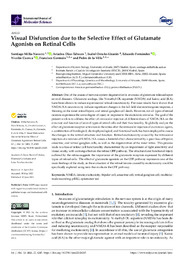Please use this identifier to cite or link to this item:
https://hdl.handle.net/11000/35407Full metadata record
| DC Field | Value | Language |
|---|---|---|
| dc.contributor.author | Milla-Navarro, Santiago | - |
| dc.contributor.author | Díaz-Tahoces, Ariadna | - |
| dc.contributor.author | Ortuño-Lizarán, Isabel | - |
| dc.contributor.author | Fernández, Eduardo | - |
| dc.contributor.author | Cuenca, Nicolás | - |
| dc.contributor.author | Germain, Francisco | - |
| dc.contributor.author | de la Villa, Pedro | - |
| dc.contributor.other | Departamentos de la UMH::Fisiología | es_ES |
| dc.contributor.other | Departamentos de la UMH::Histología y Anatomía | es_ES |
| dc.date.accessioned | 2025-01-28T18:15:25Z | - |
| dc.date.available | 2025-01-28T18:15:25Z | - |
| dc.date.created | 2021-06-10 | - |
| dc.identifier.citation | Int J Mol Sci . 2021 Jun 10;22(12):6245 | es_ES |
| dc.identifier.issn | 1793-6462. | - |
| dc.identifier.uri | https://hdl.handle.net/11000/35407 | - |
| dc.description.abstract | One of the causes of nervous system degeneration is an excess of glutamate released upon several diseases. Glutamate analogs, like N-methyl-DL-aspartate (NMDA) and kainic acid (KA), have been shown to induce experimental retinal neurotoxicity. Previous results have shown that NMDA/KA neurotoxicity induces significant changes in the full field electroretinogram response, a thinning on the inner retinal layers, and retinal ganglion cell death. However, not all types of retinal neurons experience the same degree of injury in response to the excitotoxic stimulus. The goal of the present work is to address the effect of intraocular injection of different doses of NMDA/KA on the structure and function of several types of retinal cells and their functionality. To globally analyze the effect of glutamate receptor activation in the retina after the intraocular injection of excitotoxic agents, a combination of histological, electrophysiological, and functional tools has been employed to assess the changes in the retinal structure and function. Retinal excitotoxicity caused by the intraocular injection of a mixture of NMDA/KA causes a harmful effect characterized by a great loss of bipolar, amacrine, and retinal ganglion cells, as well as the degeneration of the inner retina. This process leads to a loss of retinal cell functionality characterized by an impairment of light sensitivity and visual acuity, with a strong effect on the retinal OFF pathway. The structural and functional injury suffered by the retina suggests the importance of the glutamate receptors expressed by different types of retinal cells. The effect of glutamate agonists on the OFF pathway represents one of the main findings of the study, as the evaluation of the retinal lesions caused by excitotoxicity could be specifically explored using tests that evaluate the OFF pathway. | es_ES |
| dc.format | application/pdf | es_ES |
| dc.format.extent | 22 | es_ES |
| dc.language.iso | eng | es_ES |
| dc.publisher | MDPI | es_ES |
| dc.rights | info:eu-repo/semantics/openAccess | es_ES |
| dc.rights | Attribution-NonCommercial-NoDerivatives 4.0 Internacional | * |
| dc.rights.uri | http://creativecommons.org/licenses/by-nc-nd/4.0/ | * |
| dc.subject | NMDA | es_ES |
| dc.subject | amacrine cell | es_ES |
| dc.subject | bipolar cell | es_ES |
| dc.subject | excitoxicity | es_ES |
| dc.subject | kinate | es_ES |
| dc.subject | multielectrode recording | es_ES |
| dc.subject | retinal ganglion cell | es_ES |
| dc.title | Visual Disfunction due to the Selective Effect of Glutamate Agonists on Retinal Cells | es_ES |
| dc.type | info:eu-repo/semantics/article | es_ES |
| dc.relation.publisherversion | 10.1142/S0129065716500210 | es_ES |

View/Open:
Visual disfunction due to the selective.pdf
4,09 MB
Adobe PDF
Share:
.png)
